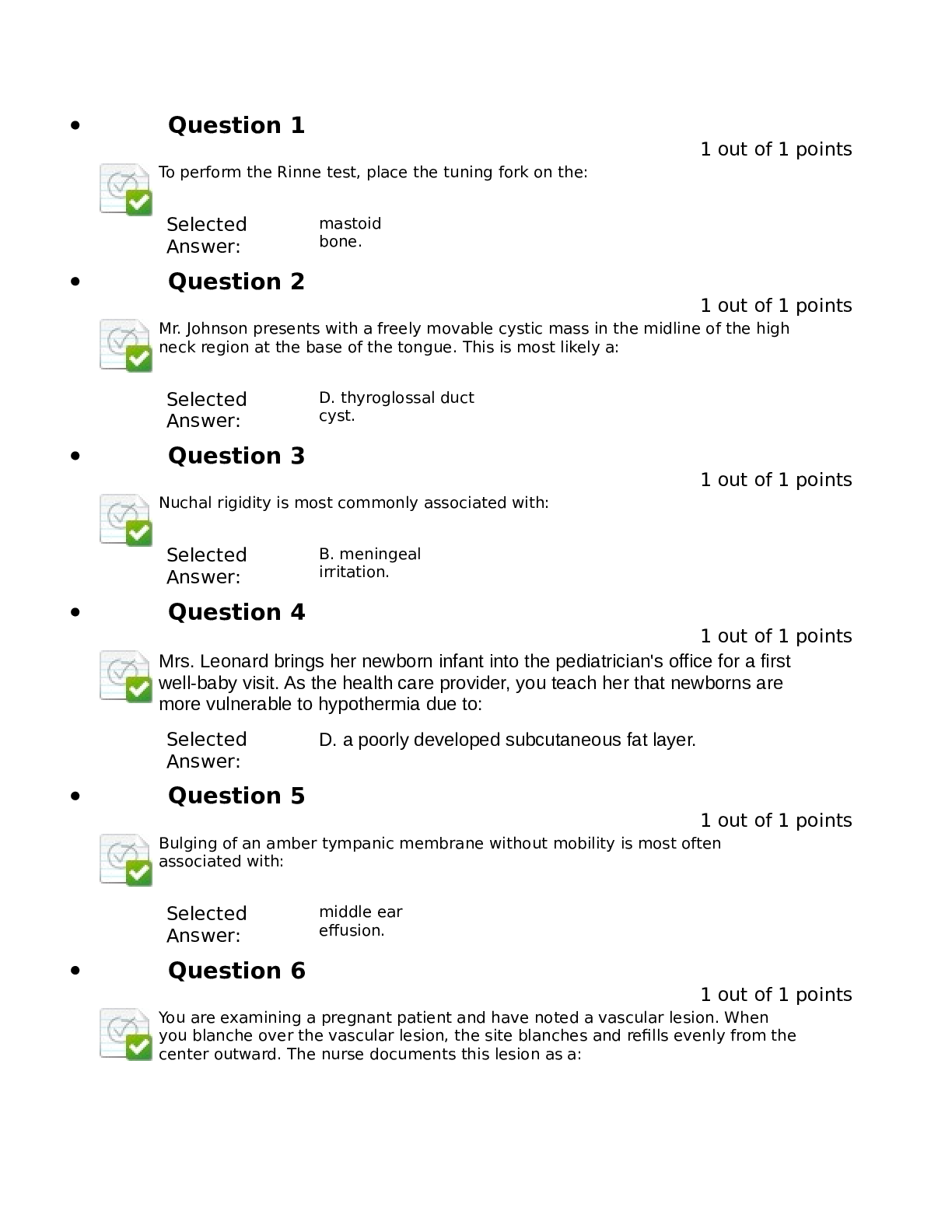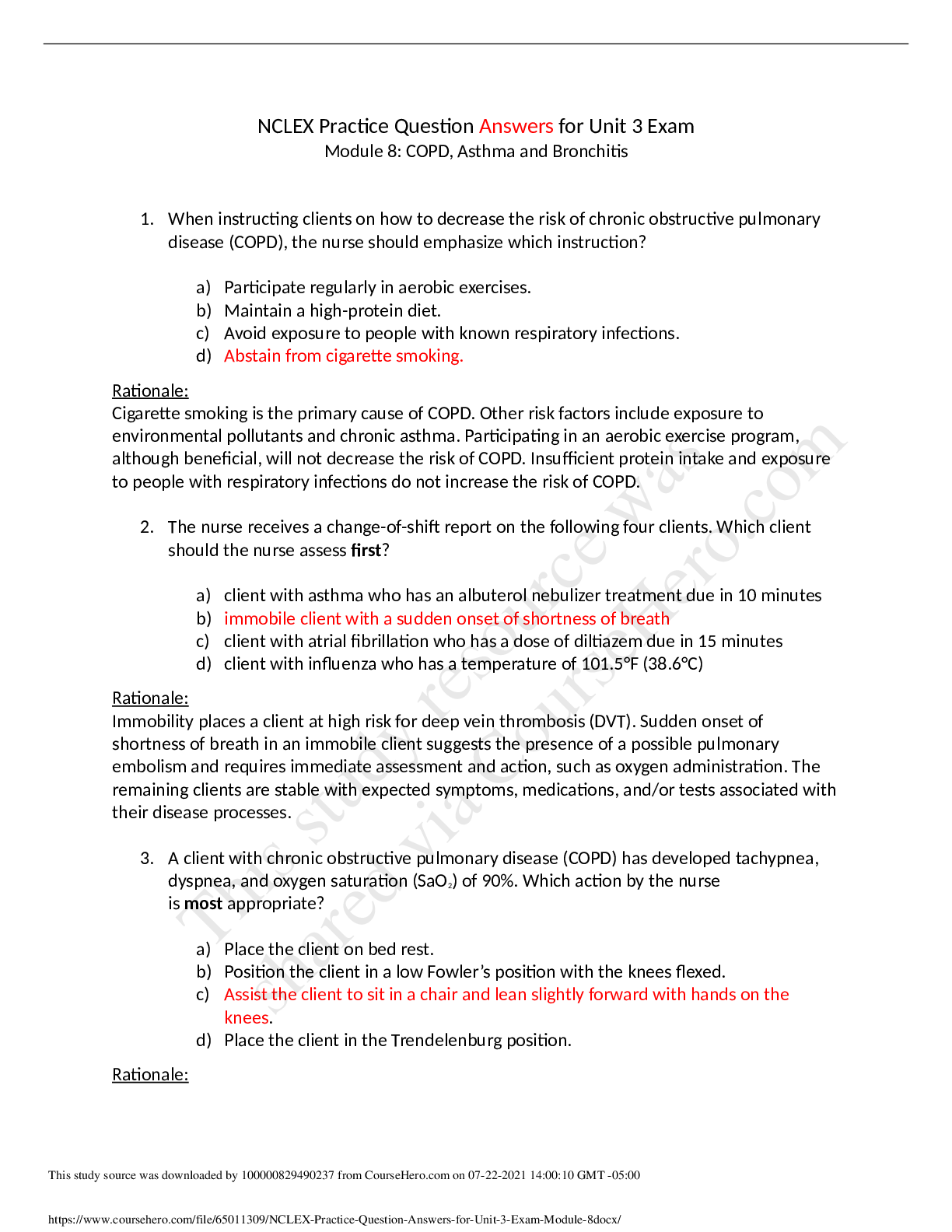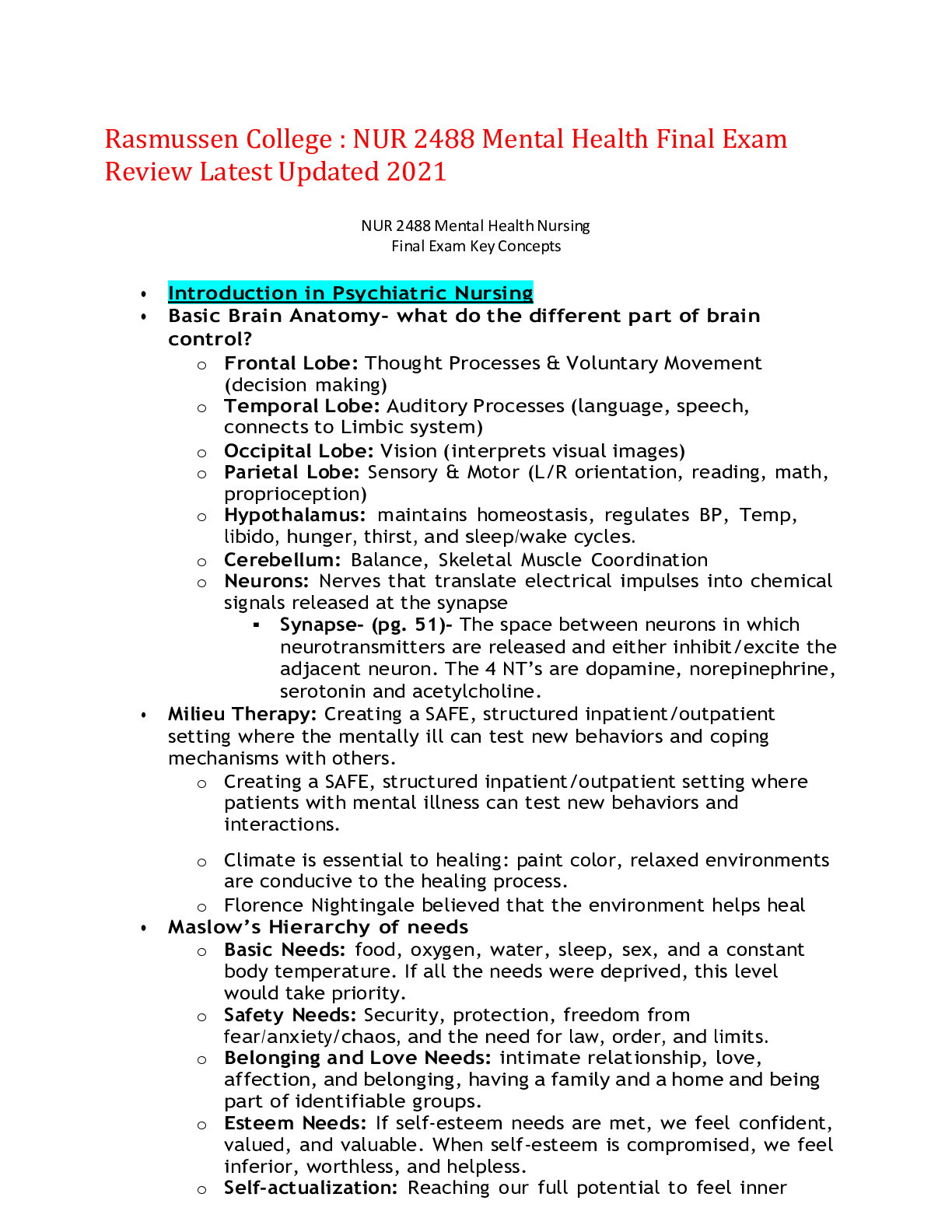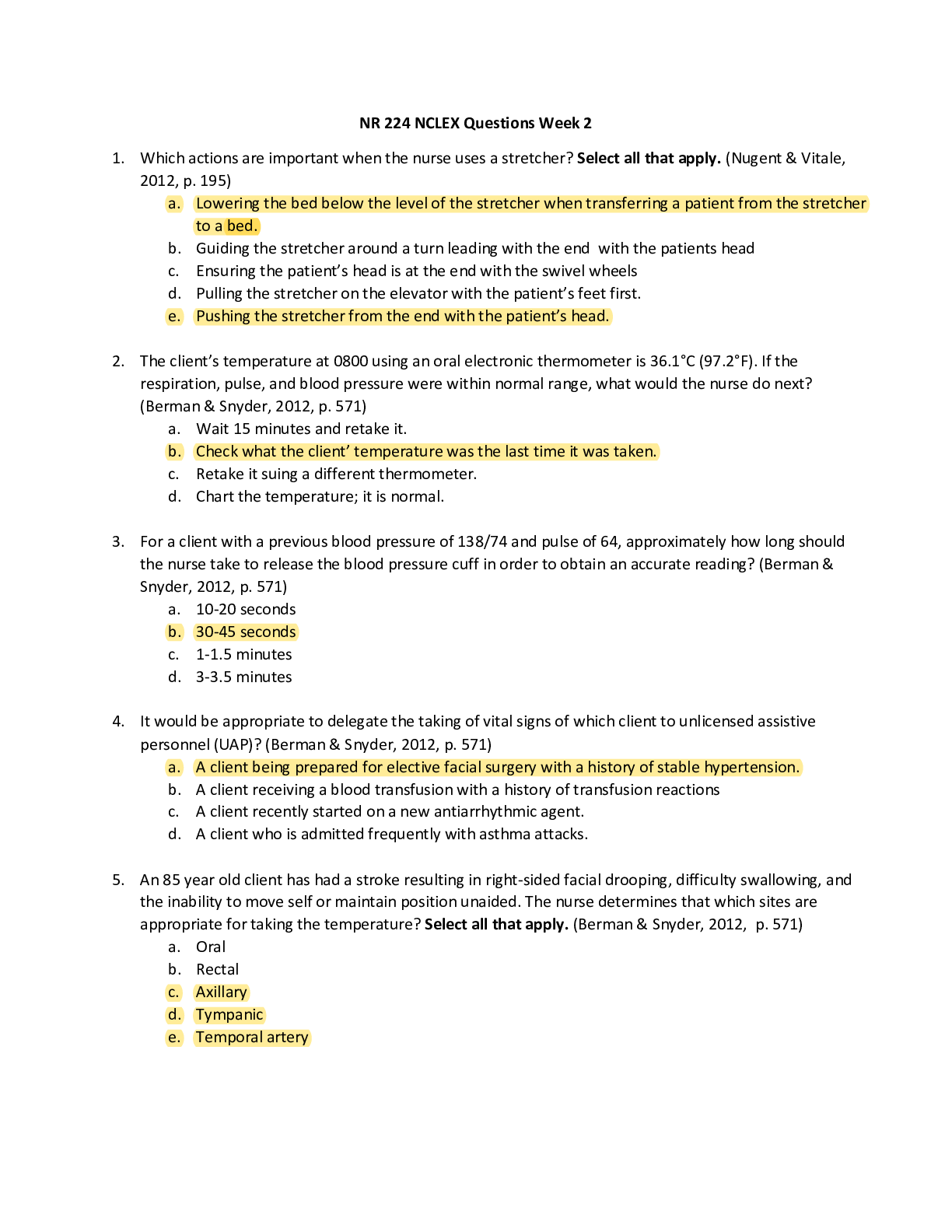*NURSING > QUESTIONS & ANSWERS > Neuro-Shock & Burns practice[WITH CORRECT 100% QUESTIONSAND ANSWERS GRADEDA+] (All)
Neuro-Shock & Burns practice[WITH CORRECT 100% QUESTIONSAND ANSWERS GRADEDA+]
Document Content and Description Below
Neuro-Shock & Burns practice 1.A nurse in the emergency department is implementing a plan of care for a conscious client who has a suspected cervical cord injury. Which of the following immediate in... terventions should the nurse implement? (Select all that apply.) A. Hypotension B. Polyuria C. Hyperthermia D. Absence of bowel sounds E. Weakened gag reflex 2.A nurse is performing discharge teaching for a client who has seizures and a new prescription for phenytoin. Which of the following statements by the client indicates a need for further teaching? A. "I will notify my doctor before taking any other medications." B. "I have made an appointment to see my dentist next week." C. "I know that I cannot switch brands of this medication." D. "I'll be glad when I can stop taking this medicine." 3.A nurse at an ophthalmology clinic is providing teaching to a client who has open angle glaucoma and a new prescription for timolol eye drops. Which of the following instructions should the nurse provide? A. The medication is to be applied when the client is experiencing eye pain. B. The medication will be used until the client's intraocular pressure returns to normal. C. The medication should be applied on a regular schedule for the rest of the client's life. D. The medication is to be used for approximately 10 days, followed by a gradual tapering off. 4.A nurse is in a client's room when the client begins having a tonic-clonic seizure. Which of the following actions should the nurse take first? A. Turn the client's head to the side. B. Check the client's motor strength. C. Loosen the clothing around the client's waist. D. Document the time the seizure began. Created on:11/26/2018 Page 1 Neuro-Shock & Burns practice 5.A nurse is caring for a client following cataract surgery. Which of the following comments from the client should the nurse report to the client's provider? A. "My eye really itches, but I'm trying not to rub it." B. "I need something for the pain in my eye. I can't stand it." C. "It's hard to see with a patch on one eye. I'm afraid of falling." D. "The bright light in this room is really bothering me." 6.A nurse is caring for a client who is 1 day postoperative following a transsphenoidal hypophysectomy. While assessing the client, the nurse notes a large area of clear drainage seeping from the nasal packing. Which of the following should be the nurse’s initial action? A. Document the amount of drainage. B. Obtain a culture of the drainage. C. Check the drainage for glucose. D. Notify the client's provider. 7.A nurse is caring for a client who has expressive aphasia following a cerebrovascular accident (CVA). Which of the following parameters should the nurse use first in order to assess the client's pain level? A. pulse and blood pressure findings B. behavioral indicators and effect C. scheduled treatments and client illness D. a self-report pain rating scale 8.A nurse is caring for a client who reports a throbbing headache after a lumbar puncture. Which of the following actions is most likely to facilitate resolution of the headache? A. Administer pain medication. B. Darken the client's room and close the door. C. Increase fluid intake. D. Elevate the head of the bed to 30º. Created on:11/26/2018 Page 2 Neuro-Shock & Burns practice 9.A nurse is teaching a class of older adults about the expected physiologic changes of aging. Which of the following changes should the nurse include in the discussion? (Select all that apply.) A. More difficulty seeing due to a greater sensitivity to glare B. Decreased cough reflex C. Decreased bladder capacity D. Decreased systolic blood pressure E. Dehydration of intervertebral discs 10.A nurse enters a client's room and finds the client on the floor having a seizure. Which of the following actions should the nurse take? A. Insert a tongue blade in the client's mouth. B. Place the client on his side. C. Hold the client's arms and legs from moving. D. Place the client back in bed. 11.A nurse is instructing the caregiver of a toddler who has bacterial conjunctivitis and a new prescription for an ophthalmic ointment. Which of the following instructions should the nurse provide? A. "Apply the ointment in a thin line into the conjunctival sac." B. "Ask the child to look down before applying the ointment." C. "Always wipe from the outer to the inner canthus when wiping away secretions." D. "Use a sterile glove and applicator to apply the antibiotic ointment." 12.A nurse is caring for a client who has a bacterial infection and is receiving gentamicin. Which of the following actions should the nurse take to minimize the risk of an adverse effect of the medication? A. Limit the client's fluid intake. B. Instruct the client to report agitation. C. Monitor the serum medication levels. D. Administer the medicine with food. Created on:11/26/2018 Page 3 Neuro-Shock & Burns practice 13.A nurse is caring for a client who was admitted to the facility in critical condition following a cerebrovascular accident. The client's son says to the nurse, "I wish I could stay, but I need to go home to see how my children are doing. I really hate to leave." Which of the following responses should the nurse make? A. "Perhaps you could call your children to see how they are doing." B. "Don't worry. We'll take good care of your parent while you are gone." C. "You are feeling drawn in two separate directions." D. "There's nothing you can do here. You should go home to your children." 14.A nurse is caring for a client who has a traumatic brain injury. Which of the following findings should the nurse identify as an indication of increased intracranial pressure (ICP)? A. Tachycardia B. Amnesia C. Hypotension D. Restlessness 15.A nurse is caring for an older adult client who was alert and oriented at admission, but now seems increasingly restless and intermittently confused. Which of the following actions should the nurse take to address the client's safety needs? A. Call the family and ask them to stay with the client. B. Move the client to a room closer to the nurses' station. C. Apply wrist and leg restraints to the client. D. Administer medication to sedate the client. 16.A nurse is caring for a client who is postoperative following a laminectomy with spinal fusion. Which of the following actions should the nurse take? A. Monitor sensory perception of the lower extremities. B. Assist the client into a knee-chest position to manage postoperative discomfort. C. Maintain strict bed rest for the first 48 hr postoperative. D. Position the client in a high-Fowler's position if clear drainage is noted on the dressing. [Show More]
Last updated: 2 years ago
Preview 1 out of 26 pages

Buy this document to get the full access instantly
Instant Download Access after purchase
Buy NowInstant download
We Accept:

Reviews( 0 )
$10.50
Can't find what you want? Try our AI powered Search
Document information
Connected school, study & course
About the document
Uploaded On
Mar 22, 2021
Number of pages
26
Written in
Additional information
This document has been written for:
Uploaded
Mar 22, 2021
Downloads
0
Views
67






.png)
.png)
.png)





